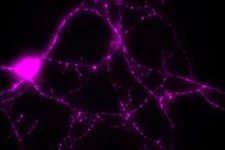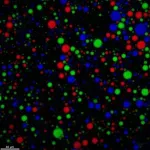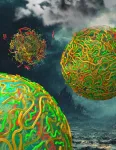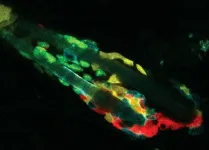(Press-News.org) An enzyme called PGK1 has an unexpectedly critical role in the production of chemical energy in brain cells, according to a preclinical study led by researchers at Weill Cornell Medicine. The investigators found that boosting its activity may help the brain resist the energy deficits that can lead to Parkinson’s disease.
The study, published Aug. 21 in Science Advances, presented evidence that PGK1 is a “rate-limiting” enzyme in energy production in the output-signaling branches, or axons, of the dopamine neurons that are affected in Parkinson’s disease. This means that even a modest boost to PGK1 activity can have an outsized effect at restoring the neuronal energy supply in low-fuel conditions—and the researchers showed that this could prevent the axon dysfunction and degeneration normally seen in an animal model of Parkinson’s disease.
“Our findings show that PGK1 can really make a big difference in Parkinson’s disease, in ways we didn't anticipate,” said study senior author Dr. Timothy Ryan, the Tri-Institutional Professor of Biochemistry at Weill Cornell Medicine. “I’m very optimistic that this line of research has the potential to generate new Parkinson’s treatments.”
The study’s first author was Dr. Alexandros Kokotos, a postdoctoral researcher in the Ryan Laboratory.
Parkinson’s afflicts about one million Americans and is the second most common neurodegenerative disorder after Alzheimer’s. The disease hits key populations of dopamine-producing neurons, initially weakening their synapses, or connection points to other neurons, and ultimately killing them. The resulting signs and symptoms of the disease include movement impairments, sleep problems and eventually dementia. Current treatments address symptoms but do not stop the disease course.
For decades, studies of various kinds have pointed to a failure of neuronal energy supply as a factor in Parkinson’s—a disease that affects neurons with very high energy requirements. Even so, researchers have lacked a good energy-related target for disease treatments.
The new focus on PGK1 originated from recent studies showing that the Food and Drug Administration-approved drug terazosin, which is used to treat prostate enlargement, also happens to enhance PGK1’s energy-production activity and has beneficial effects in multiple animal models of Parkinson’s. In these studies, however, terazosin’s ability to boost PGK1 activity was quite weak, leaving uncertainty over its mechanism of action. Further evidence of the drug’s proposed role in boosting neural protection came from a retrospective study in humans showing that terazosin significantly reduced the risk of developing Parkinson’s.
“Pharma companies have been skeptical that this weak enhancement of PGK1 can explain these benefits in Parkinson’s models,” said Dr. Ryan, who is also a professor of biochemistry in anesthesiology at Weill Cornell Medicine.
In the new study, Dr. Ryan’s team helped resolve this issue with sensitive assays that elucidated PGK1’s role as an energy producer in neurons. This role, the researchers showed, is so important that even a small boost to PGK1 activity, such as terazosin provides, is enough to keep axons functioning when levels of glucose, which PGK1 helps convert to basic units of chemical energy, are low. The experiments included low-glucose situations caused by known Parkinson’s-linked gene mutations.
The team also made a surprising discovery concerning a protein called DJ-1, whose impairment through mutation is another known genetic cause of Parkinson’s. DJ-1 is a “chaperone” that is thought to protect neurons by preventing harmful protein aggregation. However, the team found that DJ-1 works in an unexpected energy-supplying role as a close partner of PGK1—and indeed is necessary for the benefits of PGK1 enhancement.
To Dr. Ryan, the results add weight to the theory that an energy supply deficit in the most vulnerable dopamine neurons—due to aging, genetic and environmental factors—is a general early driver of Parkinson’s, and that moderately enhancing the activity of just one enzyme, PGK1, may be enough to reverse this deficit and block the disease process.
“Now I can say I’m confident that this enzyme is what should be targeted,” Dr. Ryan said. “Given the positive impact of terazosin in protecting against Parkinson’s in humans, and the fact that this drug was never optimized for PGK1 enhancement, it is exciting to consider the possible clinical impact of new drugs that, compared with terazosin, can enhance PGK1 activity more potently and selectively.”
The research described in this story was supported in part by the National Institute of Neurological Disorders and Stroke and the National Institute of General Medical Sciences, both part of the National Institutes of Health, through grant numbers NS036942, NS11739, R35GM136686, and in part by Aligning Science Across Parkinson’s ASAP-000580 and ASAP-020608 through the Michael J. Fox Foundation for Parkinson’s Research.
END
The role of an energy-producing enzyme in treating Parkinson’s disease
2024-08-21
ELSE PRESS RELEASES FROM THIS DATE:
Life from a drop of rain: New research suggests rainwater helped form the first protocell walls
2024-08-21
One of the major unanswered questions about the origin of life is how droplets of RNA floating around the primordial soup turned into the membrane-protected packets of life we call cells.
A new paper by engineers from the University of Chicago’s Pritzker School of Molecular Engineering (UChicago PME), the University of Houston’s Chemical Engineering Department, and biologists from the UChicago Chemistry Department, have proposed a solution.
In the paper, published today in Science Advances, UChicago PME postdoctoral researcher Aman Agrawal and his co-authors ...
Surprising mechanism for removing dead cells identified
2024-08-21
Billions of our cells die every day to make way for the growth of new ones. Most of these goners are cleaned up by phagocytes—mobile immune cells that migrate where needed to engulf problematic substances. But some dying or dead cells are consumed by their own neighbors, natural tissue cells with other primary jobs. How these cells sense the dying or dead around them has been largely unknown.
Now researchers from The Rockefeller University have shown how the sensor system operates in hair follicles, which have a well-known cycle of birth, decay, and regeneration put into motion by hair follicle stem cells (HFSCs). In a new study published in Nature, ...
UC Irvine discovery of ‘item memory’ brain cells offers new Alzheimer’s treatment target
2024-08-21
Irvine, Calif., Aug. 21, 2024 — Researchers from the University of California, Irvine have discovered the neurons responsible for “item memory,” deepening our understanding of how the brain stores and retrieves the details of “what” happened and offering a new target for treating Alzheimer’s disease.
Memories include three types of details: spatial, temporal and item, the “where, when and what” of an event. Their creation is a complex process that involves storing information based on the meanings and outcomes of different experiences and forms the foundation of our ability to recall and recount them.
The study, published ...
Study shows successful use of ChatGPT in ag education
2024-08-21
By John Lovett
University of Arkansas System Division of Agriculture
FAYETTEVILLE, Ark. — Artificial intelligence tools such as ChatGPT show promise as a useful means in agriculture to write simple computer programs for microcontrollers, according to a study published this month.
Microcontrollers are small computers that can perform tasks based on custom computer programs. They receive inputs from sensors and can be used in climate and irrigation controls, food processing systems, as well as robotic and drone applications, to name a few agricultural uses.
A recent study published with the Arkansas Agricultural ...
Early interventions may improve long-term academic achievement in young childhood brain tumor survivors
2024-08-21
(MEMPHIS, Tenn. – August 20, 2024) Children who survive a brain tumor often experience effects from both the cancer and its treatment long after therapy concludes. Scientists at St. Jude Children’s Research Hospital found very young children treated for brain tumors were less prepared for school (represented by lower academic readiness scores) compared to their peers. This gap persisted once survivors entered formal schooling. Children from families of higher socioeconomic status were partially protected from the effect, suggesting that providing early developmental resources may proactively help reduce the academic achievement gap. The findings were published today in ...
Cholecystectomy not always necessary for gallstones and abdominal pain
2024-08-21
Each year, 100,000 people visit their doctor with abdominal pain, with approximately 30,000 of them diagnosed with gallstones. The standard treatment for these patients is a laparoscopic cholecystectomy. Since the 1990s, the number of surgeries has increased exponentially, despite the lack of clear international criteria. As a result, gallbladder removal is one of the most common surgeries in the Netherlands, yet it is not always effective against pain: about one-third of patients continue to experience abdominal pain after cholecystectomy. The procedure has long been an example of inappropriate care, but this is now changing.
In a 2019 study conducted by Radboud university ...
Greenhouse gas HFC-23: Abatement of emissions is achievable
2024-08-21
Hydrofluorocarbons (HFCs) are potent greenhouse gases (GHGs). The most potent of these compounds is trifluoromethane, also known as HFC-23. One kilogram of HFC-23 in the atmosphere contributes as much to the greenhouse effect as 12,000 kilograms of CO₂. It takes around 200 years for the gas to break down in the atmosphere. For this reason, more than 150 countries have committed to significantly reducing their emissions of HFC-23 as part of the Kigali Amendment to the Montreal Protocol.
The main source of HFC-23 ...
Researchers identify most common long COVID symptoms in children and teens
2024-08-21
Aug. 21, 2024--Researchers from the NIH’s RECOVER Initiative have determined what long COVID looks like in youths, based on the most common symptoms reported in a study of over 5,300 school-age children and adolescents.
Using the findings, published today in the Journal of the American Medical Association, the researchers also created indices that contain prolonged symptoms—eight for school-age children and 10 for adolescents—that together most likely indicate long COVID.
The indices are not intended to be used in making a clinical diagnosis of long COVID but will guide research to improve diagnosis, treatment, and prevention of the condition in youths.
“Many ...
NIH-funded study finds long COVID affects adolescents differently than younger children
2024-08-21
NIH-funded study finds long COVID affects adolescents differently than younger children Adolescents were most likely to experience low energy/tiredness while children were most likely to report headache
Scientists investigating long COVID in youth found similar but distinguishable patterns between school-age children (ages 6-11 years) and adolescents (ages 12-17 years) and identified their most common symptoms. The study, supported by the National Institutes of Health (NIH) and published in JAMA, comes from research conducted through the NIH’s Researching ...
Characterizing long COVID in children and adolescents
2024-08-21
About The Study: In this large-scale study, symptoms that characterized pediatric postacute sequelae of SARS-CoV-2 infection (PASC), or long COVID, differed by age group, and several distinct phenotypic PASC presentations were described. The research indices developed here will help researchers identify children and adolescents with high likelihood of PASC. Although these indices will require further research and validation, this work provides an important step toward a clinically useful tool for diagnosis with the ultimate goal of supporting optimal care for youth with PASC.
Quote from corresponding author Rachel ...






